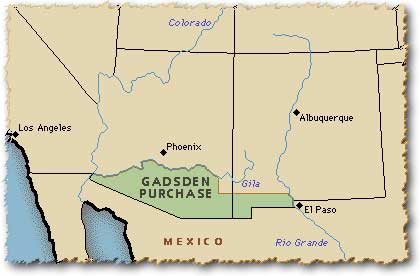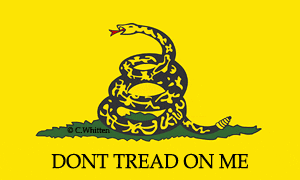|
|
|
 |
FreeRepublic , LLC PO BOX 9771 FRESNO, CA 93794
|
|
It is in the breaking news sidebar! |
|
Posted on 10/11/2003 6:01:21 PM PDT by ATOMIC_PUNK
The Gadsden Purchase was one of the most curious real estate deals in which Uncle Sam has ever taken part.
James Gadsden (1788-1858), whose name the purchase bears, was a grandson of Christopher Gadsden (1724-1805), a South Carolina Revolutionary soldier and statesman who was captured by the British at Charleston and confined as a prisoner for ten months at St. Augustine. James Gadsden soldiered for several years under General Andrew Jackson and it was he who seized the papers that led to the trial and execution of Robert C. Ambister and Alexander Arbuthnot in Florida in 1818, an incident that strained British-American diplomatic relations almost to the breaking point.
Gadsden was appointed by President Monroe as the commissioner in charge of placing the Seminole Indians on reservations. While living as a painter in Florida, he championed nullification and lost the patronage of President Jackson. He had long been interested in promoting railroads and upon his return to South Carolina in 1839 was chosen president of the South Carolina Railroad Company. His pet dream was to knit all Southern railroads into one system and then to connect it with a Southern transcontinental railroad to the Pacific, to make the West commercially dependent on the South instead of the North.
After engineers advised Gadsden that the most direct and practicable route for the Southern transcontinental railroad would be south of the United States boundary, he made plans to have the Federal Government acquire title to the necessary territory from Mexico. Through his friend and fellow empire dreamer, Secretary of War Jefferson Davis. Gadsden was appointed U.S. Minister to Mexico by President Franklin Pierce with instructions of his own design to buy from Mexico enough territory for a railroad to the Gulf of California.
It was a perfect setup. By the treaty of Guadalupe-Hidalgo, signed February 2, 1848, at the close of the Mexican War, the Republic of Mexico was compelled to abandon its claim to Texas and to cede to the United States the territory now comprising most of New Mexico, Arizona, California, Colorado, Utah and Nevada. The territory ceded to the United States by Mexico constituted about 200,000 square miles or two-fifths of all her territory.
In return for this vast territory, the United States gave $15,000,000 and assumed responsibility for paying $3,000,000 in claims of American citizens against the Mexican Government. A large body of public opinion in the United States had opposed the war against Mexico and felt that the Southern republic had been treated badly. The territory desired by Gadsden and his group was then a sort of no man's land, experiencing frequent Indian raids. The United States wanted to make certain "boundary adjustments"; Mexico needed money and wanted a settlement of her Indian claims against the United States; and Gadsden and his friends wanted a route for their railroad. In 1852 Gadsden agreed to pay Santa Anna $10,000,000 for a strip of territory south of the Gila River and lying in what is now southwestern New Mexico and southern Arizona.
Many Americans were not especially proud of the Guadalupe-Hidalgo Treaty and considered the price of the Gadsden Purchase as "conscience money." The Gadsden Purchase has an area of 45,535 square miles and is almost as large as Pennsylvania. This tract of nearly 30,000,000 acres cost Uncle Sam about thirty-three cents an acre.
The deal was so unpopular in Mexico that Santa Anna was unseated as dictator and banished. Gadsden was recalled as Minister to Mexico for mixing in Mexican politics and domestic affairs and did not live to see the Southern Pacific Railroad built through his purchase. When the inhabitants of Arizona asked Congress for a Territorial government in 1854, one of the names suggested for the new Territory was Gadsonia, a Latin adaptation of the surname of James Gadsden.
|
|
|
 |
FreeRepublic , LLC PO BOX 9771 FRESNO, CA 93794
|
|
It is in the breaking news sidebar! |
|


The acquisition of land allowed the surveying of a transcontinental railroad along a southern route wholely within the United States. But Congress was split and thus unable to agree on the route. It took the Civil War and the secession of the southern states and their senators and congressmen to allow the remaining Northerners to adopt Lincoln's proposal of the route through Iowa, Nebraska, Colorado, Utah and Nevada to California.
How different history would have been if the South had been able to use a transcontinental railroad to extend the Confederacy and slavery to the Pacific.
I prefer an educational break in what sometimes seems to be a never-ending stream of politics.
( Yes, it's a conservative forum, but sheesh! Give it a break once in a while! )

Now, Mexico has "seaports" all the way to Cleveland...
From the point of view of Arizona politics, it was a disaster.
We got that hotbed of DemocRAT politics...Tucson.
It even played a part in the Gunfight at the OK Coral. The Earps were Republican and sent in to back the Mining Interests, the Clantons backed the Cattle rustling Ranchers. The rest, as they say, was History.
Earps vs. Clantons = Republicans vs. Democrats!
That's all you need to know about that incident!
Disclaimer: Opinions posted on Free Republic are those of the individual posters and do not necessarily represent the opinion of Free Republic or its management. All materials posted herein are protected by copyright law and the exemption for fair use of copyrighted works.